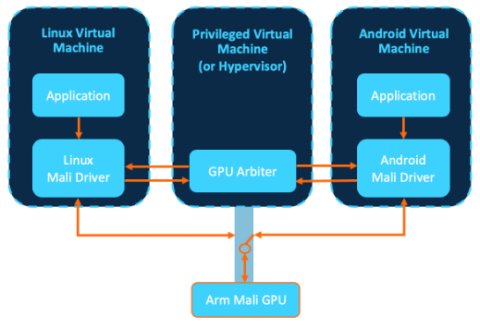Powering next-generation in-vehicle experiences with Arm Mali GPU virtualization
By Chet Babla, vice president of automotive, Automotive & IoT Line of Business
June 18, 2020 -- Based on my conversations with automakers and tier-one automotive suppliers, it’s clear there are increasing demands from consumers for a smartphone-like experience in their vehicles. In fact, despite the current economic climate, the demand to deliver new innovations and to power more displays inside the vehicle, from mirror replacement to head-up displays, remains unchanged.
These requirements for a more immersive in-vehicle, smartphone-like experience put Arm in a unique position. As the leader in both digital cockpit solutions and smartphones (85 percent of in-vehicle infotainment (IVI) solutions and 99 percent of the world’s smartphones are Arm-based), Arm applies its combined expertise in both applications into its Arm Mali graphics processor units (GPUs). And as the industry’s number one shipping graphics IP, Mali GPUs are also the world’s most ubiquitous graphics processor.
With demand for more in-vehicle displays increasing, then naturally the opportunity for more advanced applications to run on those displays increases. To ensure Arm’s extensive ecosystem can address these demands, Arm is releasing a new version of its Arm Mali Driver Development Kit (DDK) to support the key requirements of digital cockpit use-cases alongside Mali GPUs. Arm’s success in enabling seamless graphics across a variety of screens means Mali GPUs and Mali DDK solutions are built to power key in-vehicle capabilities of next-generation vehicles.
What’s particularly rewarding about my role as a leader in Arm’s automotive business is seeing carmakers bring Arm-based in-vehicle experiences to life. A recent example being Audi who are using a single Arm-based Samsung Exynos v9 SoC, powered not only by 8 powerful Cortex-A76 CPUs, but crucially also by several Mali-G76 GPUs shared between multiple workloads to enable a number of graphically-rich applications across the dashboard.
The nuts and bolts
Arm is enabling the existing Mali DDK with new virtualization support capabilities. This allows sharing of GPU resources between multiple graphically-rich applications running separate virtual machines. Additionally, Arm believes in the importance of security built in from the ground up in its IP as well as its developer tools. This is evident in the Mali DDK virtualization capabilities where one virtual machine cannot access another virtual machine’s information. The Mali DDK virtualization is designed to be completely invisible to applications as well, so developers will not need to modify their applications to support this – it’s all happening inside the driver and in system software.

Software controlled GPU virtualization. The GPU arbiter acts as a gatekeeper, ensuring each Virtual Machine gets direct and isolated access to GPU resources.
The crux of this new approach is to enable in-vehicle graphics on cockpit domain controllers. A domain controller allows multiple electronic control units (ECUs) to be consolidated into a single ECU, often with a single SoC. Previously a single ECU may perform one function, such as a digital instrument cluster showing driver speed and warning lights, while now a cockpit domain controller is able to perform multiple functions by flexibly allocating resources to multiple workloads from a single SoC. For example, a single SoC using the Mali DDK can allocate compute resources to the instrument cluster, IVI, and navigation system rather than requiring one SoC or ECU per application.
The Mali DDK supports Linux and Android, and the virtualization features can be used across multiple operating systems and hypervisors ensuring a smooth user experience such as fast touch-screen response-times in virtualized systems. Additionally, Arm support for Mali GPUs and Mali DDK in automotive applications will be tailored to the market needs to aid in the software maintenance for the lifespan of the vehicle.
The automotive industry is in the midst of delivering a faster speed of innovation than it ever has in order to keep pace with consumer expectations, and this is why the Arm automotive ecosystem has never been more vital. The Arm ecosystem has become the world’s leading compute ecosystem by enabling the demanding expectations consumers have of applications, including this exciting opportunity in immersive in-car experiences.
Chelsea Vincent
PR & Analyst Relations Manager, Arm
chelsea.vincent@arm.com
+1 512 298 8188
About Arm
Arm technology is at the heart of a computing and data revolution that is transforming the way people live and businesses operate. Our advanced, energy-efficient processor designs have enabled intelligent computing in more than 160 billion chips and our technologies now securely power products from the sensor to the smartphone and the supercomputer. In combination with our IoT device, connectivity and data management platform, we are also enabling customers with powerful and actionable business insights that are generating new value from their connected devices and data. Together with 1,000+ technology partners we are at the forefront of designing, securing and managing all areas of compute from the chip to the cloud.
Related Semiconductor IP
- Ultra-Low-Power LPDDR3/LPDDR2/DDR3L Combo Subsystem
- 1G BASE-T Ethernet Verification IP
- Network-on-Chip (NoC)
- Microsecond Channel (MSC/MSC-Plus) Controller
- 12-bit, 400 MSPS SAR ADC - TSMC 12nm FFC
Related News
- ARM's next Mali GPU tweaks Bifrost
- ARM Mali-470 GPU Offers Improved Efficiency and Experiences on Wearable and IoT Devices
- Early Adopters of ARM Cortex-A73 CPU and Mali-G71 GPU Successfully Tape-out Using Synopsys' IC Compiler II
- Cadence Delivers Rapid Adoption Kits Based on a 10nm Reference Flow for New ARM Cortex-A73 CPU and ARM Mali-G71 GPU
Latest News
- Virtusa Acquires Bengaluru based SmartSoC Solutions, Establishing Full-Stack Service Offering from Chip to Cloud and Driving Expansion into the Semiconductor Industry
- Consumer Electronics and AI Product Launches Lift 3Q25 Top-10 Foundry Revenue by 8.1%, Says TrendForce
- Joachim Kunkel Joins Quadric Board of Directors
- RaiderChip NPU leads edge LLM benchmarks against GPUs and CPUs in academic research paper
- SEMIFIVE Secures AI Semiconductor Design Projects in Japan, Accelerating Global Expansion with New Local Subsidiary